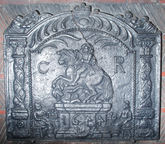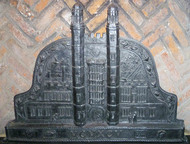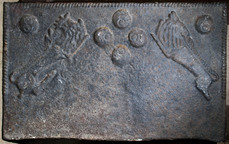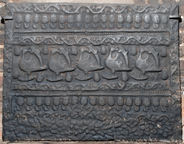-
1261
Description: Arch-shaped; fillet edge; at top, date split by crown (horizontal of '7' missing), crown over a Tudor shield, garter (motto clockwise but reversed) and supporters; rose with viscount's coronet on dexter, and portcullis (grid of 16) with viscount's coronet on sinister side of crown; the supporters, a dragon and a greyhound, stand on separate plinths; the initials, G C, are placed in either side of the garter buckle.
Notes: There are several firebacks with the Tudor royal arms that were probably originally produced in the Spanish Netherlands, perhaps illustrating the association between England and Spain through the marriage of Henry VIII and Katherine of Aragon. The firebacks differ in several small details, such as the shape of the shield, the form and rotation of the Garter motto, the style of the crown, the positioning of the supporters in relation to the Garter, and the form and size of the crowned rose and portcullis. Hôtel Drouot auction, Paris, 21 Jan 2023, lot 89.
Inscription: 15 70 / HONY SOYT QVI MAL Y PENSE / G C
Arms: Tudor royal
- Decoration tags:
- rounded arched (shape)
- fillet (edging)
- carved stamps
- whole carved pattern
- heraldic
- armorial
- royal
- text
- animals
Manufactured: in 1570 possibly in the Wallonia area of Luxemburg.
Current location: not known.
- Attached to series:
- Tudor royal armorial firebacks
- Continental Tudor royal armorial firebacks
-
1064
Description: A rectangular field with a central circle containing a fouled anchor, the rope gathered in eleven loops around it; in the top spandrels the initials HH, on the left, and IH, on the right; below the circle, the initials IM inset in a square; on each side, a strapwork Ionic pilaster formed of alternate hollow squares, with a pyramidal infill in low relief, and hollow circles; outside each pilaster, a crouching stylised humanoid figure, facing inwards, disgorging a fructed vine; above the figures two opposed volutes, forming part of the edging; above the central field, a semi-circular compartment containing a bird, its wings inverted, and three hollow diamond shapes irregularly arranged; the date above the bird; protruding from the edging above each pilaster is a small, inward-facing scroll. Three vertical plank lines can be discerned, one in front of the right-hand figure, one through the I of the initials IH, and one to the right of the second H of the initials HH. The whole design is in low relief.
Notes: This is a reworking of a design seen on a fireback of 1608 (no. 585) though intentionally stylised. The decorative elements have yet to be fully interpreted; on the 1608 version the figures are fauns, the vines disgorged from their mouths being related to the 'green man' tradition associated with woodland spirits and symbolising resurrection, the latter echoed by the bird which, on the earlier version is a phoenix. However, in the form in which they appear on both firebacks they may be purely decorative devices. By contrast, the cabled anchor is the badge of the Lord High Admiral but in 1633 the office was vacant. The initials IM indicate that this is an early work by a prolific fireback pattern-maker more usually associated with the eastern Weald.
Inscription: 1633 / HH IH / IM
- Decoration tags:
- rectangular with round arch (shape)
- fillet (edging)
- whole carved pattern
- planklines
- pictorial
- mythological
- text
- animals
- humans
- plants
- objects
Manufactured: in 1633 in the Weald area of England.
Current location: Pound Farm, Common Road, Dunsfold, Surrey, England.
Citation: Wall, J. R. S., 20 May 1965, 'Wealden Fireback' [letter], Country Life, p. 1208.
- Attached to series:
- IM series
- Brede group
-
55
Description: Canted rectangle; cavetto moulded edging (top and sides); single horizontal fillet below canted corners and vertical fillet parallel to each side, dividing the fireback into two side panels, two top corner panels, top panel and main central panel; ‘daisy’ plant stamp in top corners, and at outer end of top panel enclosing two, opposite facing, lion passant stamps with date between; swirling foliage stamp repeated in each side panel above initial, I to left, B to right; stamp of ‘Indian’ smoking a pipe in top left of central panel, stamp of seated ‘gentleman’ smoking a pipe and holding another, at top right.
Notes: The 'daisy' stamp and the IB initials are identical to those on similar firebacks dated between 1703 and 1721, and probably indicating the same founder. The use of stamps relating to tobacco smoking may suggest an origin near Bristol, the main entry port for the tobacco trade at that time. Lent to Dyrham Park by the late John Workman OBE, of Sheepscombe, Gloucs. in 1963, and given in 1996.
Inscription: 1708 / I B
- Decoration tags:
- rectangular with canted top corners (shape)
- cavetto (edging)
- carved stamps
- individual numbers
- heraldic
- text
- animals
- humans
- plants
Manufactured: in 1708 in the Forest of Dean area of England.
Current location: Dyrham Park, Dyrham, Gloucestershire, England.
Museum number: 453259 (part of the National Trust museum group)
- Attached to series:
- IB series
- Date & initials firebacks
-
1012
Description: Canted rectangle with twisted rope edging (top and sides); rope line separating rectangle from trapezoidal section, which is, in turn, separated by rope lines into a central rectangle containing a rebated lozenge stamp beneath the date (reversed), and two mirrored triangles each containing what appear to be mirrored stamps of a bird, possibly a partridge, and an initial; both the initials and the date are reversed.
Notes: Reversal of numerals and letters is not uncommon on firebacks.
Inscription: E [or] F 16 04 C
- Decoration tags:
- rectangular with canted top corners (shape)
- rope (edging)
- carved stamps
- individual numbers
- text
- animals
- objects
Manufactured: in 1604 possibly in the Weald area of England.
Current location: not known.
Citation: Eschbaecher, J., 22 Jan 1959, 'Why in reverse?' [letter], Country Life, p. 153.
- Attached to series:
- Miscellaneous stamp firebacks
- Date & initials firebacks
-
280
Description: Arched rectangular shaped central panel, bead edging (top and sides), pedestal bearing a supine male figure with headband being trampled by a horse, facing left, mounted by a rider with long hair, facing to the front; on each side of the plinth is a seated figure wearing a hat, with a basket of fruit; above the rider are crescent lines representative of clouds; the inscription is split either side of the horse; the date (‘7’ rotated and, with ‘4’, reversed) is on the die of the pedestal; arched rectangular shaped border, fillet edging, on each side a Solomonic column with vine decoration; in the arch, symmetrical parallel curved lines with a central oval cartouche beneath a crown; on top of each shoulder of the plate a figure in repose.
Notes: The equestrian figure is derived from the statue of Charles II erected in Stocks Market, London, in 1672. Originally to be of Jan Sobieski, later king of Poland, riding down a Tatar, it was altered to represent Charles, and the Tatar’s face was changed to that of Oliver Cromwell; the statue attracted a fair degree of derision. The statue is now at Newby Hall, near Ripon, North Yorkshire. Another version (no. 464), probably by the same pattern-maker, omits a date and has altered initials.
Copies of this fireback are known.
Inscription: C R / 1674
- Decoration tags:
- 'Dutch' (shape)
- cavetto (edging)
- whole carved pattern
- individual numbers
- pictorial
- historical
- architectural
- text
- animals
- humans
Manufactured: in 1674 in England.
Current location: Chequers, Ellesborough, Buckinghamshire, England.
Citation: Lloyd, N., 1925, 'Domestic Ironwork I', Architectural Review, 58, pp. 58-67.
- Attached to series:
- Carolean 'Dutch' series
- Commemorative firebacks
-
1180
Description: Quasi-arched rectangular shape; parallel simulated twisted rope edging enclosing a border of lilies; pictorial representation of the facade and gatehouse towers of Eton College, between which is a clockface below crenellation; above left, two house martins flying; at ground level, ?four people (one of which is said to be Nigel Jaques, one of the masters) all standing on a plinth bearing, in the centre, the date MCMXCV between four small cartouches, of which to the left and nearest the date is a pack of playing cards; others bear the inscriptions, MCM and CofA (Charteris of Armisfield).
Notes: Designed by and made for Martin, Lord Charteris of Armisfield, Provost of Eton (1978-91).
Inscription: MCMXCV
- Decoration tags:
- rectangular with round arch (shape)
- rope (edging)
- whole carved pattern
- pictorial
- architectural
- monogram
- text
- animals
- humans
Manufactured: in 1995 in England.
Current location: Eton College, Eton, Berkshire, England.
Museum number: FDA-A.298-2013 (part of the Eton College museum group)
- Attached to series:
- Martin Charteris firebacks
-
71
Description: Fragment; upper half of an arched rectangular shaped fireback; fillet edging; divided into two halves; left half - naked female figure of Truth holding scales in right hand, surrounded by motto ribbon bearing the text: HET IS V EEN SCHADE DAT TROVE IS LICHTER DAN EEN PLV; right half - naked female figure of Vigilance, a bird seated on her right hand, and with two dogs on leads held in her left hand, surrounded by a motto ribbon bearing the text: ICH IAGE OM DIE VINDEN OFT ICH TROVE KONDE VINDEN; initials between scales; date divided by cross of an orb forming the centre of the four intended panels.
Notes: The complete fireback has four figures (clockwise from top left) representing Truth, Vigilance (both naked), Indifference and Perfidy (both clothed).
Copies of this fireback are known.
Inscription: SG 1598 HET IS V EEN SCHADE DAT TROVE IS LICHTER DAN EEN PLV / ICH IAGE OM DIE VINDEN OFT ICH TROVE KONDE VINDEN
- Decoration tags:
- rectangular with round arch (shape)
- fillet (edging)
- whole carved pattern
- individual numbers
- allegorical
- text
- animals
- humans
- objects
Manufactured: in 1598 possibly in the Lorraine area of Germany.
Current location: Godalming Museum, Godalming, Surrey, England.
Museum number: B980.407 (part of the Godalming Museum museum group)
- Attached to series:
- Virtues and Faults firebacks
-
1207
Description: Rectangular; twisted rope edging (top and sides); in the upper part of the plate, between a leopard passant guardant sinister (on the left) and a leopard passant (on the right), a domed roundel bearing an off-centre smaller roundel within an edged circular depression, repeated four times in diamond pattern, with the smaller roundels orientated towards the centre of the arrangement; in the top corners, two more domed roundels, their smaller roundels orientated towards the bottom of the plate.
Notes: The roundel stamp has not been noted on any other firebacks. One of the legs of the leopard on the left and both legs of the leopard on the right are missing, suggesting that the stamps, which appear complete on many firebacks, were well used and had been damaged; this suggests a relatively late use of these stamps. Gorringe's auction, Lewes, lot 82, 2 Aug 2021 (£170). Bishop & Miller Auctioneers, Stowmarket, 27 Jan 2022, lot 383 (£2,900).
Copies of this fireback are known.
- Decoration tags:
- rectangular (shape)
- rope (edging)
- simple stamps
- carved stamps
- heraldic
- animals
- objects
Manufactured: in the mid- to late-16th century in the Weald area of England.
Current location: not known.
- Attached to series:
- Royal series
-
996
Description: Quasi-rectangular shape (42.5mm wider at the bottom); border formed of strips carved with an undulating vine (top and sides); successive rows of repeated stamps: (from top) 18 'hops' or 'grape bunches' in line, horizontal fillet with line of beads below, line of vine strips, 5 birds (probably swans, a Lancastrian badge) in line with 'hops'/'grape bunches' at top and bottom of gaps, line of vine strips, line of beads with horizontal fillet below, 17 'hops'/'grape bunches' in line, and line of vine strips (partially obscured by what appears to be the repeated pressing of finger tips into the casting sand to form an extension at the base).
Notes: One of a series of firebacks incorporating the use of the undulating vine strip, and the 'swan' stamp. This may be a recasting produced by the firm of Charles Wayte & Cheverton, formerly of Edenbridge, Kent, as a similar back was illustrated in their catalogue.
- Decoration tags:
- rectangular (shape)
- trailing vine (edging)
- simple stamps
- carved stamps
- heraldic
- animals
- plants
- objects
Manufactured: in the late-16th century possibly at Pounsley Furnace, Framfield in the Weald area of England.
Current location: in private hands, Goudhurst, Kent, England.
- Attached to series:
- Pounsley series
- Vine strip series
- Swan series
- Furniture stamp firebacks
-
1226
Description: Rectangular; rope edging (top & sides); in centre, Tudor shield, garter, crown and supporters (greyhound and lion) between two fleurs-de-lys; date top left.
Notes: A badly corroded fireback. The armorial achievement is seen on other firebacks and was formed from four separate stamps; the supporters are consistent with the date; the style of the numerals is uncharacteristic of the period. The sharpness of the detail on the crown and upper part of the Garter indicates that the fireback is contemporary with the date, and not older as similar examples seem to be. The same date in identical form is on a similar fireback at Penshurst Place, Kent.
Inscription: 1579 / [Garter motto incomplete]
Arms: Tudor royal
- Decoration tags:
- rectangular (shape)
- rope (edging)
- carved stamps
- date stamp
- heraldic
- armorial
- text
- animals
Manufactured: in 1579 in the Weald area of England.
Current location: Groombridge Place, Speldhurst, Kent, England.
- Attached to series:
- Tudor redated series
- Pounsley series
- Tudor royal armorial firebacks
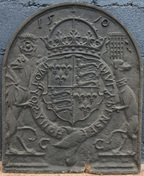

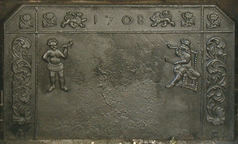
 762x533.jpg)
